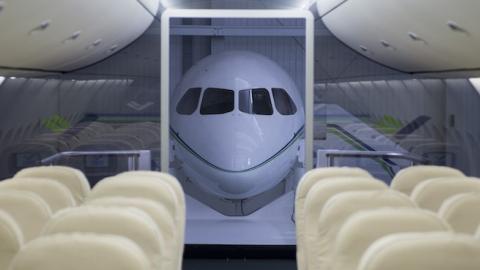In 2008, the government set up the Commercial Aircraft Corporation of China to try to break into the commercial airplane market dominated by America’s Boeing and Europe’s Airbus. With the 100-200 seat single-aisle passenger airplane market worth an estimated $US20 trillion over the next 20 years, Beijing has pulled out all the stops to help state-owned COMAC break into what many consider to be the world’s toughest market in any sector.
The story so far for COMAC is not encouraging. The smaller ARJ-21 aircraft, which carries less than 100 passengers, has been beset by continual delays with the latest report that it will be able to enter service at the end of 2014 have been in development since 2003 even before COMAC was formed.
The record for development of the C919, which can seat up to 174 people and on which Beijing is placing its main hopes on in the all-important 100-plus passenger market, is even worse. The C919 will not have its first proper test flight until at least 2015 with a market release date of 2018. Most credible analysts believe it will be sometime in the next decade until the C919 enters the market and, when it does, the C919 will be obsolete vis-à-vis new and upgraded models that Boeing and Airbus will bring to the market before then.
All this is reflective of the challenges faced by a Chinese government that insists every important and lucrative sector be led by designated 'national champions' (state-owned enterprises under close supervision from the government) rather than private firms.
It is more than likely that an SOE will be able to successfully build a passenger plane that works and is even certified by international regulatory authorities. But building a successful and profitable commercial passenger plane business that can compete with the best in the world is the real challenge for COMAC, and China’s other 'national champions'.
In addition to the understandable desire to break into a lucrative market, Beijing is quite explicit that the ability of a national champion to build a passenger jet will serve as proof of China’s emergence as a genuinely high-tech and advanced economy that can match the best leaders in Asia, Europe and North America.
To do so, COMAC has pursued the same strategy followed by China’s state-owned high-speed rail firms: engage in domestic manufacturing of passenger aircraft using foreign designs from joint ventures; develop Chinese designs from these foreign blueprints with the help from foreign manufacturers; and then build an aircraft using wholly domestic (predominantly state-owned capabilities) without any foreign existence.
That Chinese SOEs in the high-speed rail sector did this through initially inviting Japanese and German firms into joint ventures before cancelling contracts part of the way through, and subsequently introducing domestically built high-speed trains almost identical to the designs of Japanese and German trains is the darker side of Beijing’s industrial strategy. In particular, state-owned CSR Sifang Locomotive’s claim to ‘digest’ all the technology it needed in a mere two years during a joint-venture with a leading Japanese high-speed rail company, the Kawasaki consortium, is scarcely believable for a company that knew very little about high-speed rail when the joint-venture began. CSR Cifang’s trains look exactly the same as Kawasaki’s, while 98 per cent of the technology and internal design of the Chinese trains are the same as Kawasaki trains.
When it comes to building Chinese passenger planes, COMAC is currently at stage two: development Chinese designs from foreign blueprints with the help of foreign manufacturers. There has been Chinese progress in many areas and capabilities needed to build a successful and certifiable passenger jet plane. Where there have been obstacles, leading American and European companies such as GE, Rockwell Collins, Honeywell and Liebherr have been paid handsome sums to help COMAC develop major subsystems and key parts that are beyond the Chinese company. With help from international partners, COMAC will eventually get passengers travelling on an ARJ-21 or C919.
But this does not mean that COMAC will get a significant slice of the commercial airplane market and make a dent in Boeing or Airbus’ stranglehold. Indeed, the odds are that it will not.
For a start, those committed to buying COMAC planes when they eventually pass all regulatory and air safety standards and are ready to fly have been forced by Beijing to do so. From latest reports, almost all advanced purchase of COMAC aircraft have been Chinese domestic airlines, which accounted for 251 of the 267 orders (94 per cent) for the ARJ-21. Of the 380 advanced orders for the C919s, 370 are by domestic Chinese airlines. These Chinese airlines have been compelled by Beijing to choose COMAC over Boeing and Airbus aircraft.
As far as external airlines are concerned, the only one that has made advanced orders for COMAC aircraft are state-owned airlines in Laos, after concerted diplomatic pressure by Beijing was placed on its small client state neighbour. State-owned airlines from Myanmar, another client state of China’s until recently, had ordered two ARJ-21s, but has recently cancelled these orders.
The broader point is that Chinese national champions like COMAC rely on state largesse and support in important ways for their existence and markets. Besides getting Beijing to do the selling and marketing for them, COMAC does not face competition from domestic rivals. As a result, it has little need or experience in cobbling together an effective marketing, positioning or branding strategy that can convince independent airlines to purchase its planes. As it is, brand ‘China Inc’ has a hard enough time convincing independent buyers that its advanced products can meet or surpass world-class safety and reliability standards.
Then there is the issue of failure to integrate systems that continues to plague COMAC. Pouring money and offering privilege and protection to firms, which is an essential element of Beijing’s ‘national champion’ approach, can achieve good progress when it comes to developing advanced parts, components and designs. (A bit of intellectual property theft doesn’t harm either in this respect: the ARJ-21 has a suspicious resemblance in technology and design to McDonnell Douglas planes such as the MD-80, which was once built in China.)
But systems-integration -- bringing together the hardware, software, partner networks/relationships/capabilities, marketing/sales/branding functions etc -- is another matter. This is something much harder to buy with state money. The development of systems integration comes from cutting one’s teeth in genuinely competitive marketplaces and having the commercial freedom to outsource key processes to other partners (that COMAC cannot do to the same extent since Beijing insists that maximum value creation and essential processes be retained within the country and among a network of SOEs.)
For example, COMAC does not have the capacity to build a world-class logistics and servicing network for its aircraft, something Boeing and Airbus must do to help maintain their all-dominant market share. To do that, COMAC will need to cooperate with multiple commercial partners within China but also around the world. Whereas world class companies call this rational outsourcing to achieve the world’s ‘best practice’, Beijing sees this as a loss of control over and dilution of value of its ‘national champion.’
Even when it comes to ensuring that the airplane works safely and reliably, COMAC would have to fully integrate into the global commercial aviation manufacturing industry as Boeing and Airbus have done. But this could only occur if COMAC’s primary mission was to become the best international commercial airplane company it could be, rather than becoming China’s ‘national champion’.
In the end, COMAC will eventually get its planes into the market. But they will be obsolete, have no track record of reliability or safety, and lack a global part and servicing support network. In particular, when the C919 eventually is available to buy, COMAC (and Beijing) will have to decide whether they want to spend billions more dollars developing a newer version of the C919 and the necessary systems integration capabilities that it needs to be an attractive proposition.
If COMAC can one day cut it with Boeing and Airbus, then China as a country and economic system will have come of age. Until then, and while the notion of a ‘national champion’ in an advanced sector might appeal to the nationalist and control streak in all of us, they will not match their multinational private sector rivals.
















